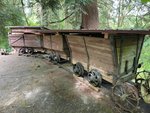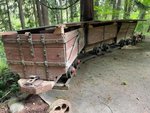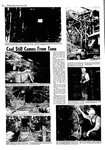


Sometimes you find gold where you least expect it. Or, in the case of the city of Tenino, perhaps coal.
But that’s not a bad thing.
Tenino and the nearby area was once well-known for its abundance of ad-hoc mining companies that sprung up in the Skookumchuck and Hanaford valleys.
So it came only as mild surprise when city staff came upon a trio of coal carts listed for sale on Facebook Marketplace. Thanks to generous donations from businesses with the Tenino Area Chamber of Commerce this week, Mayor Wayne Fournier purchased the carts, which are believed to have been used in nearby coal mines.
The carts will be donated to the Tenino Depot Museum where they will be displayed in an exhibit. The museum, which is funded largely by donations, is currently raising money to build an exterior display for the wood-and-metal carts.
But, before all that, city historian Rich Edwards must determine if the carts are legitimate or not, as well as their age. Based on preliminary investigation work, it’s believed they’re from the era of local mining, which broadly spanned more than a century between when pioneers first claimed the area until after World War II.
Fournier said the seller claims the carts were used in the Black Diamond Coal Mine in Tono, an abandoned coal town located about 3 miles southeast of Bucoda and whose name, according to Edwards, is shorthand for “ton of coal.”
“They look to be the right style and we have some photos of the mining carts that were used back in the day,” Fournier said. “They would have been used in the coal mines to haul coal from the depths … which is pretty cool.”
The seller, a woman who lives off Little Hanaford Road in what was then prime coal country, was very accomodating, Fournier said, and voiced a desire to see the carts preserved.
Jessica Reeves-Rush, director-curator of the Tenino Depot Museum, said while she hasn’t seen the carts in person, pictures posted by Fournier on Facebook seem convincing.
“They look to me like coal carts and they reminded my father of coal carts he used in Bucoda. They still had coal carts around when he was kid,” she said.
Even if they’re not authentic, Reeves-Rush said, they look convincing enough that the museum could use them as an educational example of what carts looked like even if they’re replicas.
The depot museum, which boasts “thousands” of historic displays, doesn’t have much in the way of coal mining artifacts aside from some mining hats, detonators and lunch pails, to name a few.
People come in often to donate their historically-significant items to the museum, but Reeves-Rush said they’ve never had something “quite like this. This is something we could use to make a scene and I’m very excited about this.”
Fournier said officials plan on picking the carts up next week and begin determining how to display them. Alongside Edwards, who said he hasn’t yet seen the carts or started research, the team will review newspaper articles and research to determine the carts’ authenticity.
“We have some pictures, we have some tooling, but this would certainly be the biggest item going back into coal history,” Fournier said of the museum contribution. “We really feel like our museum is not just preserving history, but contributing to the story.”
Speaking to The Chronicle over the phone on Thursday, Edwards said there have been reports of a mine in Tono that was operating under a local family’s control up until 1966, back when there were only about 60 coal miners working in the entirety of Washington state.
“There’s a lot of coal mining that went on in the area,” he said. “The area became so well-known for coal that the first Post Office became known as ‘Coal Bank.’”
Tono was just one of many coal mining boom towns that sprung up in the area. Life revolved around the industry for many of these towns, with schools, shops and houses constructed to house families and workers.
Many folded around the time of the Great Depression and as the United States entered World War II.
“A few of them operated in smaller veins, no pun intended, into the 1960s and ‘70s,” Edwards said.
Fournier brought the idea to purchase the coal carts to the local chamber of commerce during a luncheon meeting held Wednesday.
Tyler Whitworth, former chamber president and Oregon Trail Days organizer, was at the meeting and contributed a substantial chunk of the $2,500 asking price for the carts.
Whitworth said, in true Tenino fashion, they rallied enough money in just minutes to help the city and museum out with the project.
“Wayne’s excitement, he has a vision for Tenino and I think it really shows that people trust him and the museum and everyone else,” Whitworth said. “I wish I would have had it on video.”
Usually if Tenino residents have a solid idea, Whiworth said, the community will rally behind it. That was the case with these carts.
“We really feel that our museum is pretty special for this area,” he said. “I think the more we can accumulate, the more we know that museum will be a draw for people and the county.”
Whitworth said it’s also exciting because the city should have the carts in possession by Oregon Trail Days, which the chamber is tentatively planning on bringing back this year following cancelation last year due to COVID-19.